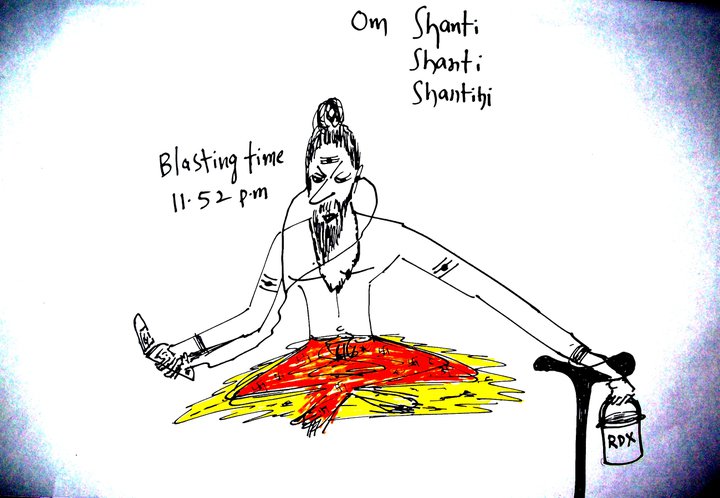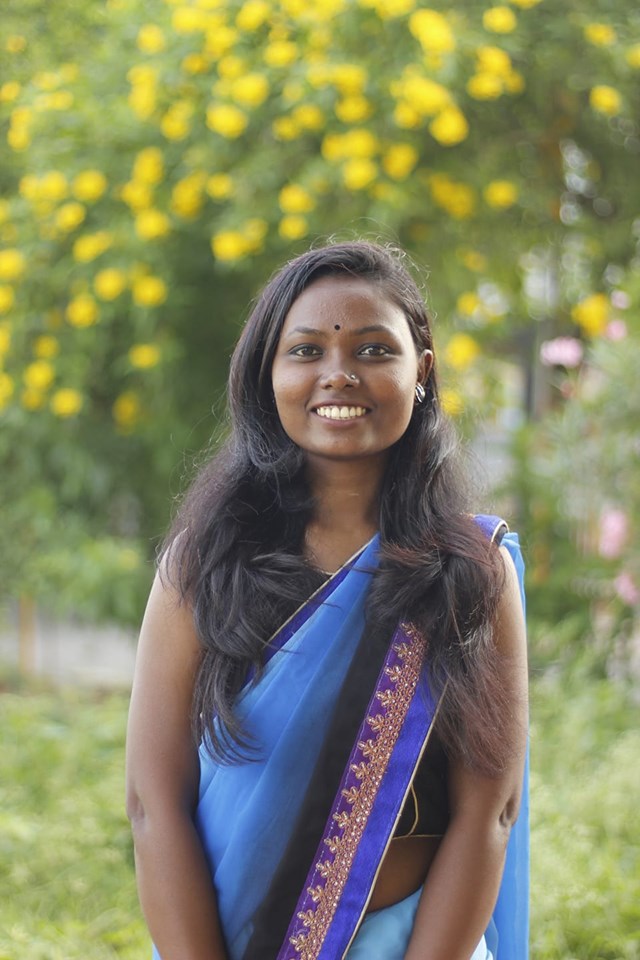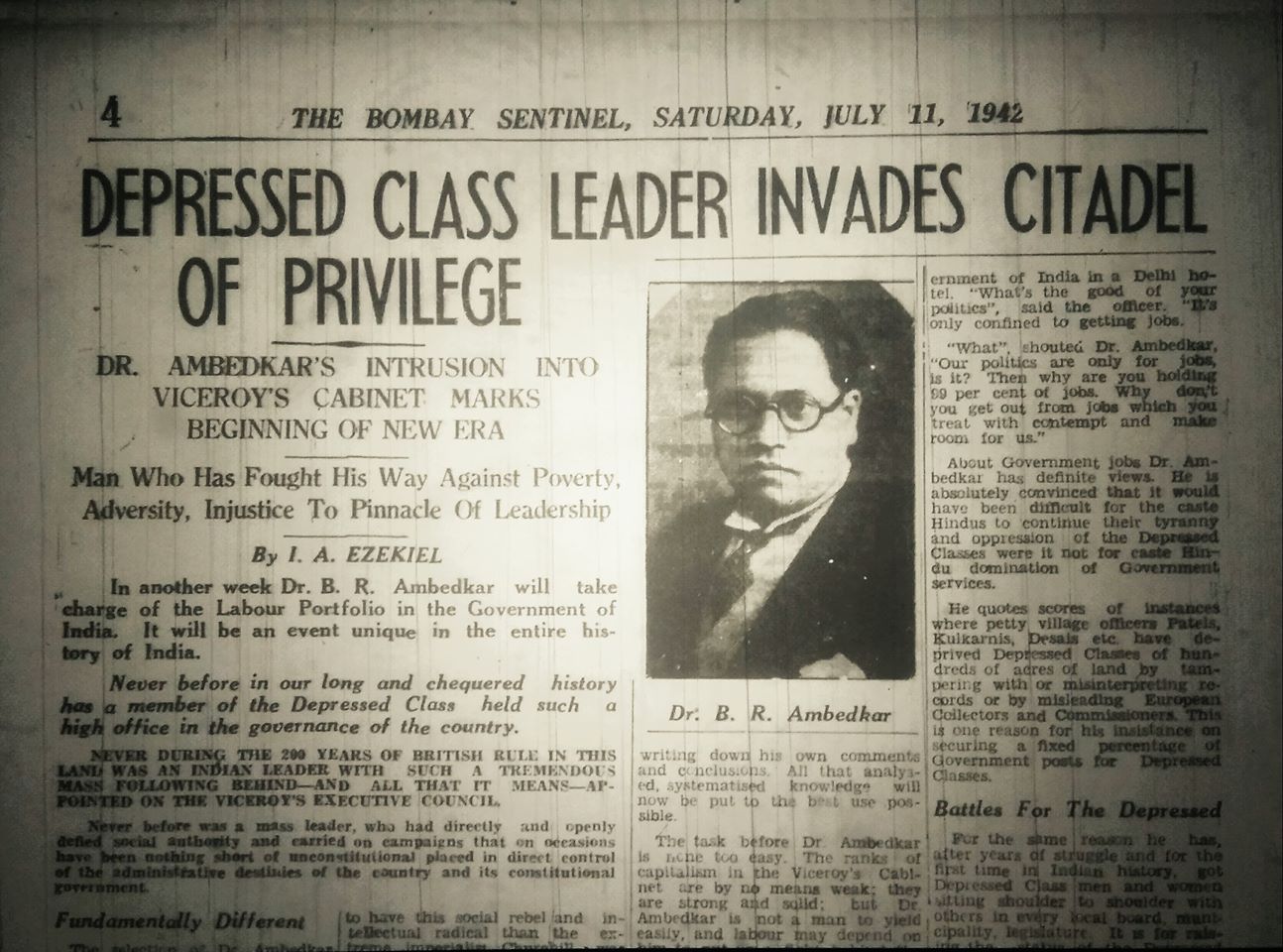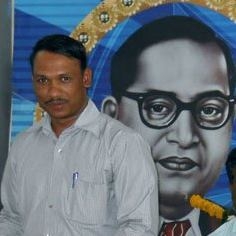Kuffir
Gujarat
Is an experiment
To see if a state would grow
When you sow blood
~ Netala Pratap Kumar
Not just Gujarat, but the whole of India has been an experiment, in essence, since its formation as a state herding together disparate pieces of political, cultural and social geography into a make-believe nation. In the process of inventing a nation to legitimize the state, terror or the sowing of blood can be identified as the only consistent strategy adopted by the ruling classes over the decades.

The bogey of ‘love jihad’ has revived this article which had remained as a draft for quite a few years. A familiar hate tune which brings back so many terrifying memories is being played out again by the Indian state. I had first started on this draft a day after the Mecca Masjid blasts in May 2007, when the police outside the Masjid had killed more people than the bombs which went off inside. That bitter irony was more compounded by later events which resulted in the completely partisan actions of the investigating agencies which picked up dozens of young muslims from the old city of Hyderabad and subjected them to months and years of unlawful detention and torture, hardly noticed by any of those dominant sections of society which seemed the most agitated by the blasts. All the while, the real culprits remained free to plan more mayhem.
Dr. Ambedkar had said:
Most people do not realize that society can practise tyranny and oppression against an individual in a far greater degree than a Government can. The means and scope that are open to society for oppression are more extensive than those that are open to Government, also they are far more effective. What punishment in the penal code is comparable in its magnitude and its severity to excommunication?
That was from a speech he had delivered on the occasion of Ranade’s birth anniversary in 1940, a few years before independence. But as we can see, as illustrated so clearly in the Mecca Masjid instance, political tyranny of the government had struck up a very cozy relationship with social tyranny of the custodians of custom and tradition, a relationship which has grown stronger and broader with every new government, no matter who headed it.
This marriage of social tyranny and political oppression becomes more clearly visible whenever an incident of terrorism as defined by the ruling classes, such as a bomb blast or a mass shooting by non-state actors, erupts.
It’s been seven years since the Mumbai attacks, over four years since the last Mumbai blasts and the last Delhi blasts, fifteen months since the last Hyderabad blasts and barely eight since the latest Patna blasts.
With every new incident, it became more and more clear that political tyranny, under the ‘modern’ garb of democracy and secularism, marched in step with the centuries old entrenched social tyranny of the Brahmanized classes. How quickly they forgot the fact that the terrorists who planted those bombs in Mecca Masjid drew their spiritual inspiration from a ‘cultural’ institution just a few hundred kilometers north-west of Hyderabad, rather than from any ‘camp’ northwest of Amritsar!
The political leadership of the country never attempted to see what the social tyrants didn’t want them to.
This article follows the trail of some of those episodes of ‘terrorism’ to explore the politics that utilizes these incidents to stir the popular imagination selectively and strongly to push into the background acts of terror several hundred times more lethal.
Terrorism is what follows it
When Dr. Ambedkar designed the constitution, he had clearly envisaged a different role for institutions of governance, law making and justice; that they would infuse the much needed ideals of liberty, equality and fraternity into society. That the political leadership would temper and ultimately work towards annihilating the social tyranny of caste society. The Telugu poet S. K. Yousuf Baba says:
He sat on a throne
and made my Dalits sit on the ground
told my Adivasis to stay at his feet
we folded our hands and stood,
bringing palms together was all he ever taught my people;
changing religion was a rebellion
my people stood shoulder to shoulder
and entered mosques and churches;
his ego received a blow,
so he divides and kills and shows his true colours
once again..
What’s the poet talking about? Ancient history? The brahminized political leadership, which Dr. Ambedkar had perhaps hoped would somehow adapt themselves to new historical changes triggered by movements for political and social freedom sweeping across the world, was finding new ways to exclude, segregate, disenfranchise and, most importantly, divide the labourers already divided by birth into various marginalized groups, even as they talked in the glib language of democracy and egalitarianism.

Consider very recent history: after the Mumbai attacks, savarna netizens, the latest tentacle of the octopus of social tyranny, seemed to wish to do all kinds of things to Chidambaram and Kasab and Pakistan. The only solution that many sections of the indignant classes seemed to have found to the problem of terrorism was to kill Kasab. They seemed to find much economic justice too in executing Kasab because keeping him in jail costs a lot of money, according to some very inventive online accountants. And the government obliged.
But less than two days after the Patna blasts, the ‘national’ discourse had already moved on to whether Patel would have made a better prime minister than Nehru, and to even more pertinent issues such as: did Nehru attend Patel’s funeral? Such smooth transition from bombs to idle coffeehouse chatter: what could be more terrifying?
What had changed?
Terrorism, as defined so narrowly by the governing classes, as Dr. Ambedkar called them, seems to rouse savarna India to anger only when it hurts its very feudal sense of pride and honour. Mumbai and Delhi, for instance, seem to represent India’s honour more than Patna or Malegaon. Justice seems to be still a distant dream for all those killed in Mumbai and Delhi, apart from all the other places, but it does not seem to matter to the ruling classes much. They have ‘punished’ Kasab, and that’s enough for them.
It also does not seem to matter to the Indian state that it had chosen the most unjust way possible, as recognized by most of the civilized world, to penalize Kasab. By pandering once more to their base khap-like instincts to teach Pakistan a ‘lesson’, to assuage their warped sense of honour, the ruling classes had cut their sanctimonious ahimsa-snorting nose to spite their own facade of democracy.
It is not just a select few among the so-called terrorist acts of violence which provoke this selective sense of outrage, other public acts of violence like the Nirbhaya atrocity (because it happened in a space seen as very savarna?) are also seen as attacks on savarna honour. All the horrific assaults on Dalit women in Haryana happening around the same time – no mainstream feminists seemed to have heard of them.
Yes, the Indian ruling classes seem to react more with a sense of hurt pride and honour than from a sense of justice when faced with violence they think is somehow directed against them.
And there were others, also savarna, who wished to point out it’s the Parivar etc who have created the kind of fear-filled atmosphere which leads to these kind of retaliatory attacks.
Both together seem to have a strong interest in choking the etherspace with their respective views on the same incidents, crowding out voices emanating from all other tragedies clamouring for space. Their politics of choosing a few particular tragedies over the overwhelming rest is terrorism by other means. Because the incidents that they don’t consider terrorism are no less terrifying. They’re in fact the real story of the operation of the unique ethos that informs the Indian state and society, of the venomous ideology of brahminism.
Terrorism is what terrorism hides
Where, the sword of caste
hangs over our throats, always,
the gun of religion
remains pointed at our hearts
human relations can only thrive
as oceans of tears.
~ kO.pra
Most of this note has evolved over the years the UPA government was in place, updated periodically with new incidents that engaged both the so-called opposing sections of Indian ruling classes. One way or the other, it was plain, both sections considered the same kind of incidents significant.
But look at the incidents of terrorism they ignored every day (first highlighted by NCDHR in 2008):
Police statistics averaged over the past five years show that every week: thirteen Dalits are murdered, five Dalits’ homes or possessions are burned, six Dalits are kidnapped or abducted; every day: three Dalit women are raped, eleven Dalits are beaten up; and for every eighteen minutes a crime is committed against a Dalit.[2] This is despite the fact that many Dalits do not report crimes for fear of reprisals by the dominant castes. Despite twenty-seven officially registered atrocities being committed against Dalits every day, the police often prevent Dalits from entering police stations, neglect their cases and even partake in torture.
And other incidents of terrorism, like violence against, and killing of muslims – which the media makes you think happens only during huge events like the riots in Gujarat, or before and after events like Babri Masjid etc, events coyly referred to as incidents of communal violence – which happen every day (compiled by PRS Legislative Research in 2011):
During 2005-09, 648 people were killed and 11,278 injured in 4,030 incidents of communal violence- On average, 130 people died and 2,200 were injured in communal violence each year. Incidents were reported from 24 of the 35 states and union territories. The maximum number of incidents occurred in Maharashtra (700), followed by Madhya Pradesh (666) and Uttar Pradesh (645).
And the scores of thousands of ‘terrorists’ killed in Kashmir over the last three decades – in incidents involving fewer victims than the major massacres – mostly in ones and twos and threes (like during the normal everyday ‘incidents of communal violence’ in india) — figures you wouldn’t notice because they’re so small and alone, individually unable to wriggle out of the tiny nether corners of newspapers to catch your attention, that they slowly become the normal static of life in everyday India, eagerly guided by the media through this process.

Not to speak of the always unheard incidents of unspeakable terrorism in the little hills and towns of the Northeast (always northeast of you, the centre). Unheard because sound takes a great deal of time to travel from there to the centre. At times, news of a young woman fasting over there over some incomprehensible piece of legislation reaches you only when she has become a decade older. Therefore, some smarter young people from over there are lugging their voices over to the centre, to Delhi and other big cities so that that you may hear them faster. But the bodies attached to those voices aren’t very welcome in Delhi, for instance.
Of around 60 incidents of rape, or terrorism, reported every day in India, Delhi claims credit for one-fifth. But no one in Delhi gives any credit to the women who produce probably 60% of the food consumed by all the bodies in India. And those women themselves don’t give themselves much credit either– they probably consume around one-fifth of the food they produce.
Terrorism is what causes it
I am the moonlight
in Guja-raatri*,
The last breath
in the ruins of the destroyed Babri masjid..
~ Sivasagar.
All of India has always been engulfed in a long, never ending Guja-raatri. Here, all mainstream politics is terrorism by other means. Which doesn’t mean politicians alone are terrorists, as most of the brahminized classes would like to see them.
The likes of Andre Beteille ruled over the social sciences establishment of India for decades: didn’t they practise the terrorism of killing caste in the academia? Is it very surprising then, for instance, that 98.4% of all professors in 25 Central Universities in India, as some activists now point out, belong to the upper castes?
And why should it be considered surprising if one links that absence of caste, and the literal absence of lower caste bodies and minds, in the realm of education and knowledge, to the terror of segregation and much worse visited upon Dalit and Adivasi communities periodically across the country? How should one classify the politics practised by the academia?
Or the Hazares and the Ramdevs who can’t even think of giving up a meal over Khairlanji or Karamchedu – what are the politics the civil society practices?
Or the media who turned Mayawati bashing into a mission for over a decade? That is a very minor example of their politics.
Or the slow but steady genocide of various adivasi groups through the emasculation of their habitats, grabbing of their lands, extinguishing of their livelihoods.
What the brahminized classes or the ruling classes or the governing classes deem terror or terrorism and what they do not, what they ignore and what they highlight, what kind of violence they talk about and create discourses around and what they don’t, what kind of tragedies they consider significant and worth researching and what they don’t, what kind of threats endanger ‘national security’ and require decisive action and what don’t – everything is calculated and planned, and the real terrorism lies there.
Even their noise, their inefficiency and their bumbling is purposive and so are their formally expressed ‘political’ divisions. All part of a coordinated team effort, most times. The brahminized classes dominate all status quoist and dissenting political platforms, the civil society, media, academia and the voluntary sector. That’s the team.
The results of their politics are there for the whole world to see and shrink back in terror: malnutrition rates that are higher than in the supposedly worst governed countries in the world, starvation deaths even in metropolitan cities, mass killings in the most ‘developed’ states. The highest incidence of child prostitution, bonded labour, and even slavery. And the largest, most informalized workforce in the world without even the most minimal social security support. That doesn’t cause terror among the brahminized classes.
Because all their politics is terrorism by other means. Terror is their stock-in-trade. A different kind of terror for each of the different kinds of marginalized groups. Designed to raise or lower the level of vulnerability of any particular group, already rendered extremely susceptible to exploitation and oppression due to the precariousness of their economic/livelihood conditions, at will, depending on political necessity.
So a rumoured ‘eve teasing’ incident can cause the Muzaffarnagar massacre, just as it caused another, over twenty years ago in Tsunduru. Time is just another helpless bystander in Guja-raatri.
A couple of weeks ago KCR, who had promised loan waiver for the Telangana farmers during the polls, suddenly decided to bring in new conditionalities to determine eligible beneficiaries. Three farmers committed suicide in his own constituency overnight. Couldn’t you say their lives were switched off from a remote control device held in the rulers’ hands?

Why would a couple of more suicides terrorize the brahminized classes if over 2,00,000 suicides of mostly OBC and now Dalit farmers in the last two decades couldn’t? Nor could the suicides of weavers, goldsmiths and countless other kinds of artisans.
What’s the way out of this all pervading Guja-raatri? J. Gautam says:
When the time was right they called for a struggle for freedom
Through the scheme of transfer of power they became the rulers..
and also the opposition
Sporting a red rose, they spread a red carpet
for capital
They penetrated Marx’s beard and Lenin’s button
and called themselves the left
If they approved, it was progress, and casteism if they disagreed
Russia’s the weapon they said, China’s empowered they said
The mind’s Mao’s, they said, and the patent is ours, they said
They turned specific realities unspecific..
There is a need to understand this multi-hooded caste serpent more seriously, to challenge it more resolutely if the marginalized ever hope to see the light at the end of this Guja-raatri.
*The full translations of the Telugu poems featured in this article can be found at: The Shared Mirror, a Dalit Bahujan literary site. The names of the translated poems, in the order of their appearance in the article are: Dalita Naaniis, by Netala Pratap Kumar; Muslim Wadas, by Skybaba; No one’s a bigger killer than God, by Ko.Pra; I, by Sivasagar and The conspiracy against the pointer finger, by J. Gautam.
~~~
Cartoons by Unnamati Syama Sundar.
A slightly different version was published in ‘The Baroda Pamphlet’.










